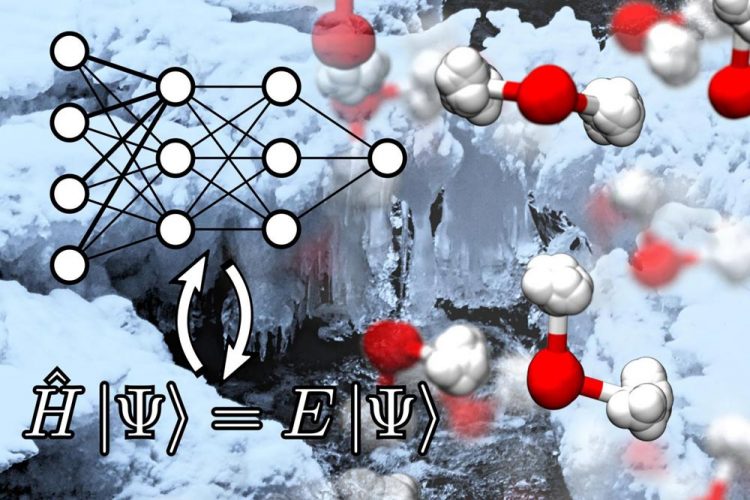Machine learning and quantum mechanics team up to understand water at the atomic level

For ubiquitous and technologically essential system of water, a first-principles thermodynamic description not only leads to excellent agreement with experiments, but also reveals the crucial role of nuclear quantum fluctuations in modulating the thermodynamic stabilities of different phases of water. Credit: Michele Ceriotti
To overcome these harsh limitations, the researchers exploited an artificial neural network (ANN) to learn the atomic interactions from quantum mechanics. The architecture of ANNs can be represented as several layers of interconnected nodes, which mimics the structure of the neurons in a human brain.
The ANN first learns quantum mechanical interactions between atoms, and then make speedy predictions about the energy and forces for a system of atoms, bypassing the need to perform expensive quantum mechanical calculations.
So far, it all rather sounds like a typical success story of machine learning. However, there are subtleties. The ANN has a residual error compared to the actual quantum mechanical calculations: most of the times it introduce a small noise, and sometime it makes a wild guess if an input is very different from anything it has learned. How to avoid the pitfalls of the ANN?
Instead of employing ANN on its own to make predictions about a system of atoms, the researchers used it as a surrogate model. In essence, computing properties of materials at a finite temperature usually involves many computation steps, the laborious and repetitive parts can be delegated to the cheap surrogate model.
Finally, the difference between the surrogate and the ground truth, which is the difference between the ANN and quantum mechanics, can be accounted for and subtracted from the final predictions.
With these techniques, the researchers were thus able to to reproduce several thermodynamic properties of water from quantum mechanics, including the density of ice and water, the difference in melting temperature for normal and heavy water, and the stability of different forms of ice.
Moreover, the study reveals several physical insights on what give ice and water systems their peculiar properties. One of the most notable findings is the that nuclear quantum fluctuations, which is the tendency for light elements such as hydrogen to behave more like a diffuse cloud rather than a localized particle, promote hexagonal packing of molecules inside ice, which ultimately leads to the six-fold symmetry of snowflakes.
Media Contact
More Information:
http://dx.doi.org/10.1073/pnas.1815117116All latest news from the category: Physics and Astronomy
This area deals with the fundamental laws and building blocks of nature and how they interact, the properties and the behavior of matter, and research into space and time and their structures.
innovations-report provides in-depth reports and articles on subjects such as astrophysics, laser technologies, nuclear, quantum, particle and solid-state physics, nanotechnologies, planetary research and findings (Mars, Venus) and developments related to the Hubble Telescope.
Newest articles

Recovering phosphorus from sewage sludge ash
Chemical and heat treatment of sewage sludge can recover phosphorus in a process that could help address the problem of diminishing supplies of phosphorus ores. Valuable supplies of phosphorus could…

Efficient, sustainable and cost-effective hybrid energy storage system for modern power grids
EU project HyFlow: Over three years of research, the consortium of the EU project HyFlow has successfully developed a highly efficient, sustainable, and cost-effective hybrid energy storage system (HESS) that…

After 25 years, researchers uncover genetic cause of rare neurological disease
Some families call it a trial of faith. Others just call it a curse. The progressive neurological disease known as spinocerebellar ataxia 4 (SCA4) is a rare condition, but its…





















